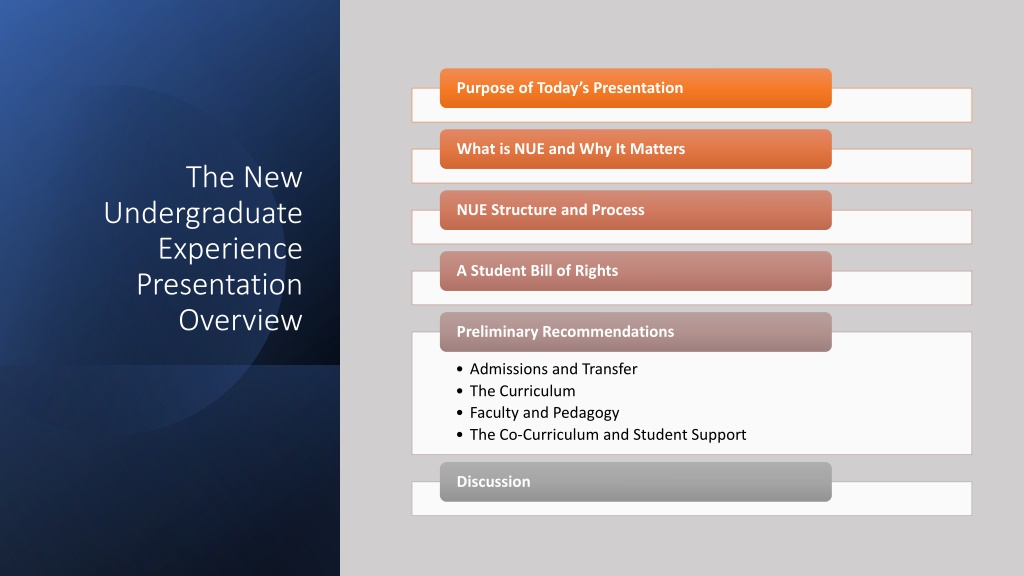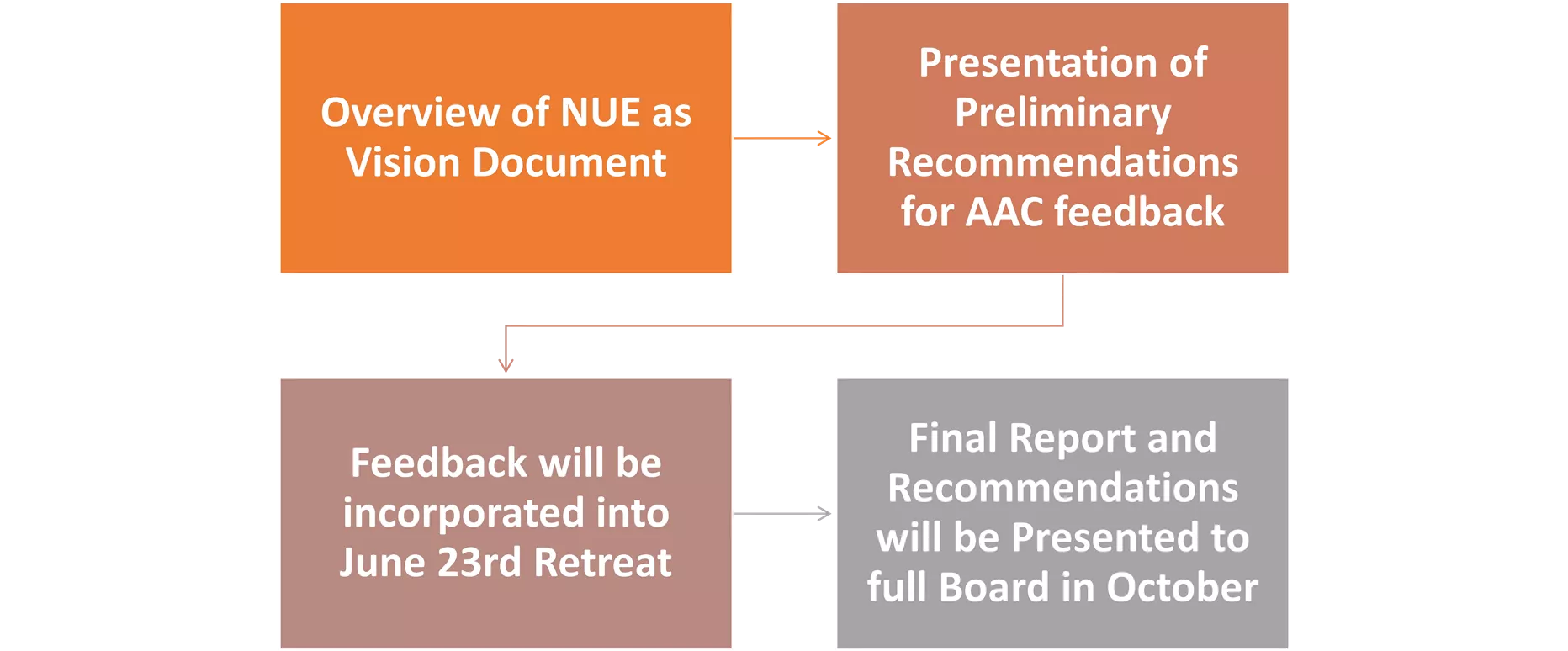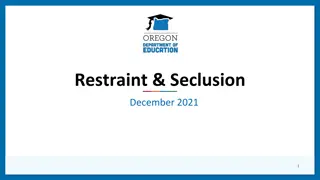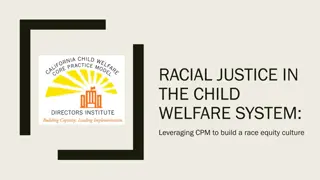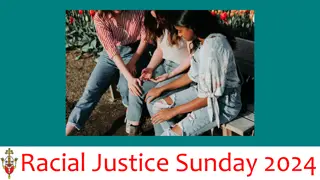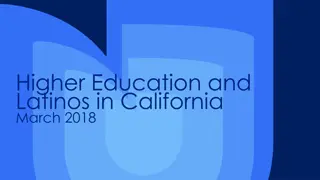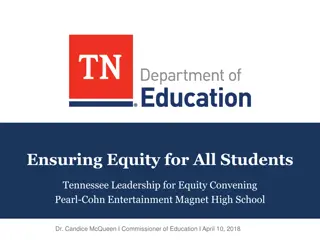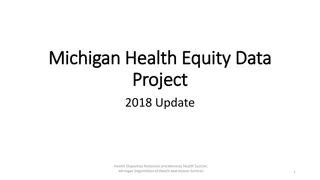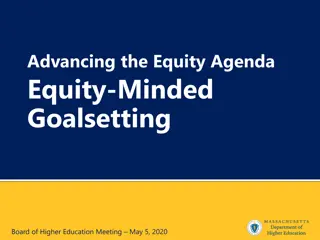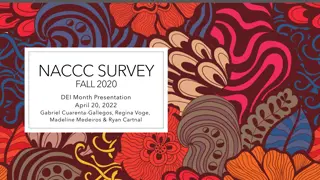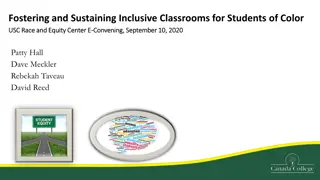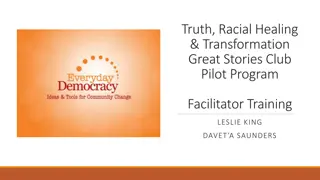NUE and Racial Equity in Higher Education
This presentation delves into the New Undergraduate Experience (NUE) and its focus on advancing racial equity in public higher education. It highlights the intersectionalities of students and addresses the widening equity gap in completion rates. The NUE initiative aims to recognize students' assets, redesign academic structures, and drive transformative change.
Download Presentation

Please find below an Image/Link to download the presentation.
The content on the website is provided AS IS for your information and personal use only. It may not be sold, licensed, or shared on other websites without obtaining consent from the author. Download presentation by click this link. If you encounter any issues during the download, it is possible that the publisher has removed the file from their server.
E N D
Presentation Transcript
Purpose of Todays Presentation What is NUE and Why It Matters The New Undergraduate Experience Presentation Overview NUE Structure and Process A Student Bill of Rights Preliminary Recommendations Admissions and Transfer The Curriculum Faculty and Pedagogy The Co-Curriculum and Student Support Discussion
Purpose of Todays Presentation Purpose of Today s Presentation Presentation of Preliminary Recommendations for AAC feedback Overview of NUE as Vision Document Final Report and Recommendations will be Presented to full Board in October Feedback will be incorporated into June 23rd Retreat
Massachusetts public higher education institutions educate adults, parents, workers, part-time students, transfers, career-changers, certificate students, and stop-outs. Our students are first-generation, low- income, LGBTQIA+, English language learners, and racially, religiously, and neurologically diverse. These intersectionalities of race, class, gender, disability, sexuality, nationality, place of origin, and religion profoundly shape how students engage with higher education and should be thought of as assets they bring with them to enrich our institutions. NUE s NUE s Foundational Foundational Principles Principles The fundamental premise of the New Undergraduate Experience is that the mission of public higher education as an engine of socio-economic mobility and critically engaged citizenship, must be realized through a commitment to advancing racial equity and justice in higher education. Central to the project of advancing racial equity is a relentless belief in the strengths, assets, and cultural wealth of all our students, as well as a recognition that our academic structures, policies and practices have functioned as barriers to student success. NUE s recommendations therefore focus on building the capacity of staff and faculty to recognize the assets our students bring with them and to facilitate their learning and success, and on redesigning our institutions, systems, and structures rather than remediating students. NUE aspires to be bold, visionary and transformative.
Our data show that while overall completion rates are improving, the equity gap is widening Source: MA DHE Data Center
The blue bars demonstrate that students of color with unmet need are more likely to be found in the lower Expected Family Income (EFC) ranges than white students Source: MA DHE Data Center
But inequitable outcomes are not attributable to socio-economic status alone. Controlled for SES, students of color still have inequitable access and outcomes.
Policy & Program Equity Audit Expand Data Dashboard NUE is an Integral Part NUE is an Integral Part of the DHE s Equity of the DHE s Equity Action Plan Action Plan Re-Imagine the Student Experience Through NUE Launch the DHE Strategic Planning Process
NUE NUE Builds on Existing NUE Builds on Existing DHE Equity Efforts, and DHE Equity Efforts, and Ensures Others Adopt Ensures Others Adopt an Equity Focus an Equity Focus OER & Equity- Minded Assessment (AMCOA) Basic Needs Security Advisory Committee Test-Optional Admissions Pilot Dev Ed Reform & Mass- Transfer CDEP and Early College Civic Learning & Engagement Policy CPL/PLA Consortium MassTeach & STEM Starter
Committees and Structure Committees and Structure Steering Committee Co-Chairs: Patty Eppinger and Dr. Constanza Cabello Teaching and Learning Committee Student-Ready Institutions Committee Tri-Chairs: Dr. Paul Hernandez, Cynthia Lynch, and Dimitri Moore Tri-Chairs: Dr. Deanna Yameen, Marquis Taylor, and Dezary Guzman Faculty, Curriculum and Pedagogy Professional Development and Assessment Holistic Student Supports Foundational Elements Institutional Culture Transitions 9
Stakeholders and Process Stakeholders and Process Broadly inclusive membership of 60+ people representing all Broadly inclusive membership of 60+ people representing all 29 institutions, from Presidents and Chancellors to executive 29 institutions, from Presidents and Chancellors to executive leadership, administrators, staff, faculty and students, and leadership, administrators, staff, faculty and students, and external partners such as employers, advocacy external partners such as employers, advocacy organizations, the K organizations, the K- -12 sector, and the AAC&U 12 sector, and the AAC&U Weekly/ Biweekly Working Group Meetings 6 Student Focus Groups with Students from NUE and SAC Three All- Committee Joint Meetings One All- Committee Retreat (upcoming) Monthly Committee Meetings
What Our Students Want: Additional Support at Important Moments of Transition To See Their Identities Reflected and Valued in the Curriculum and on the Campus To Be Represented in Student Government and to Have a Voice in Decisions that Affect Them For Institutions to be Transparent and Accountable in Implementing the Equity Agenda Key Themes Key Themes from Student from Student Focus Groups Focus Groups 11
Students Have The Right To: Clear, accessible, and understandable financial information, and affordable and predictable education costs Welcoming, inclusive, and safe campus environments Equitable access to experiential learning opportunities, in and out of the classroom A Student Bill A Student Bill of Rights of Rights Inclusive, anti-racist,andculturally responsivecurricula and pedagogies Diverse and supportive faculty and staff who are equity-minded higher education practitioners Timely and relevant pathways to graduation and employment A voice in the decisions that impact their education But to fulfill these promises to all our students, we must focus on racial equity 12
Cross-Cutting Recommendations The access, success, retention, persistence and graduation of our Black, Latinx, Asian, Indigenous and other students of color will be prioritized The Equity Agenda will be the guiding paradigm for the curricular and co- curricular undergraduate experience Data must be both disaggregated and intersectional All trustees, executives, faculty, and staff will participate in racial educational equity professional development Accountability structures will be created to ensure that racial equity and justice progress is being made Equity-based policy and program audits will be regularly implemented by institutions and system
18.00% Admissions & Transfer 16.00% 14.00% 12.00% Race-neutral admissions policies have resulted in greater under- representation of students of color at our 4-year institutions 10.00% 8.00% 6.00% 4.00% 2.00% Source: Education Trust s State Equity Audit 0.00% Black Latinx State Population All Public 4-Years Umass Amherst
Goals Replace race-neutral admissions policies that have been shown to advantage white students with race-conscious admissions policies and practices Eliminate barriers in application and enrollment for students of color and for populations of students where students of color are over-represented Achieve racial equity in enrollment and transfer, so that student diversity reflects the diversity of local and state populations. Admissions & Transfer KeyPreliminaryRecommendations Examine admissions practices through a racial equity lens Develop opt-out admissions policies Develop a statewide dual admission program Institutions will be required to use the Massachusetts Articulated System of Transfer (MAST) common course numbering system Develop system that will automatically contact qualifying transfer students to complete the ReverseTransfer/FERPA release form when eligible for the associate degree. .
Revised Placement and Gateway Math Enrollment and Completion 70.00% Developmental Education, English Language Learners (ELL), & Credit for Prior Learning (CPL) 60.00% 50.00% 40.00% Developmental Education is a Barrier to Student Success 30.00% 20.00% 10.00% 0.00% Enrolled F18 Completed F18 Enrolled F19 Completed F19 Source: MA DHE Enrollment and Completion Data Black Latinx White
Goals Developmental Education, English Language Learners (ELL), & Credit for Prior Learning (CPL) Eliminate barriers for students of color to enroll in credit-bearing coursework Replace deficit and remediation models with asset and strengths-based approaches that recognize student cultural wealth Key Preliminary Recommendations Reconvene and charge statewide Developmental Education Advisory Board with phasing out non-credit Developmental Education Create and charge a DHE-led state-wide ELL working group with redesigning and aligning ELL programs Strengthen Prior Learning Assessment (PLA or CPL) consortium by including 4-year Institutions Create transfer agreement and partnership among all 4-year institutions to recognize Credit for Prior Learning awarded by community colleges
A Rejuvenated Core Curriculum In a society marked by deep and persistent disparities based on race, ethnicity, and socioeconomic status, LIBERAL EDUCATION OFFERS THE BEST MEANS TO THE DEMOCRATIC END OF UNIVERSAL ACCESS TO OPPORTUNITY AND TO FULFILL THE PROMISE OF SOCIAL MOBILITY. Put simply, if the learning outcomes of a liberal education correspond to the proficiencies required for engaged citizenship and for success in the workplaces of today and tomorrow and educators and employers alike agree that they do then liberal education can unleash the potential of those otherwise most likely to be excluded from full participation in civic and economic life. Association of American Colleges and Universities, What Liberal Education Looks Like: What It Is, Who It s For, and Where It Happens (2020)
KeyPreliminary Recommendations Goals: A system-wide Core framework that is student-centered, culturally relevant, and learning outcomes- driven, with racial justice, equity, and recognition of student cultural wealth as foundational principles Replace General Education terminology with Core Curriculum Create and charge a broadly inclusive working group with the examination and re- design of the Core Replace diversity or multicultural Gen Ed requirements with a racial equity and justice Institutional Learning Outcome A Rejuvenated Core Curriculum
High-Impact Practices & the Co-Curriculum High Impact Practices (HIPs) are Effective in Improving Outcomes for Black and Latinx Students and Closing Equity Gaps Source: Tennessee Board of Regents and the Lumina Foundation, February 2021
High-Impact Practices & the Co-Curriculum HIPs Make College Graduates More Attractive to Employers Source: Ashley Finley, How College Contributes to Workforce Success: Employer Views on What Matters Most (AAC&U, 2021)
KeyPreliminary Recommendations Goals Recognition that HIPs and co- curricular learning ( experiential learning ) are essential to both liberal arts and professional education and are effective in closing equity gaps and ensuring graduate employment Achieve racial equity in student participation and successful outcomes in experiential learning opportunities Implementation of co- curricular learning outcomes, including awareness of and competence in racial justice and equity. Create visible mentoring networks of faculty, staff, alumni, and employers of color Identify and eliminate barriers to high-impact/co- curricular experiences and prioritize participation and success of all students of color Create system-wide community of practice that includes employers as well as higher education practitioners High-Impact Practices & the Co-Curriculum
Hiring, Supporting & Retaining Faculty & Staff of Color BIPOC Adjunct Faculty The Diversity of Our Students Is Not Reflected in the Diversity of Our Faculty BIPOC Fulltime Faculty BIPOC Students 0.00% 10.00% 20.00% 30.00% 40.00% 50.00% 60.00% Source: MA DHE Student Enrollment and Employee Date UMass SU's CC's
KeyPreliminary Recommendations Goals Each campus will have a CDO with sufficient resources Implement hiring, tenure, and promotion processes that prioritize racial equity and equity-mindedness Institute a DHE- supported, system- wide commitment to developing students of color to be the faculty of the future A highly diverse faculty and staff at our public institutions that reflect the diversity and identities of our students Institutional cultures that acknowledge, recognize and reward the invisible labor of faculty and staff of color Hiring, Supporting & Retaining Faculty & Staff of Color
Equity-Minded Teaching, Learning & Assessment & Professional Development For Faculty & Staff Professional Development Works: When Faculty Re-Design Their Courses and Pedagogies, Equity Gaps Close and All Students Benefit Source: CUE s Impact on Equity Gaps (https://cue.usc.edu/about/equity/impact/)
Goals Teaching and learning experiences that are student-centered, affirm students cultures and identities, cultivate critical consciousness of race, gender, and intersectional identities, maintain high expectations for academic success and teaching excellence, and utilize low-cost and no-cost classroom materials (OER) Race-conscious, holistic, qualitative as well as quantitative assessment of student learning, featuring disaggregated data by race and gender as well as intersectional factors such as first-generation status and age A faculty and staff adept in culturally responsive/sustaining, trauma- informed practices and pedagogies and universal design (UD), committed to designing curricula that reflect the diversity of student experiences and identities, aware of the histories of racial inequity and injustice that have shaped higher education and our society generally, and committed to using data and assessment to improve practices Equity-Minded Teaching, Learning & Assessment & Professional Development for Faculty and Staff KeyPreliminaryRecommendations Enhance and scale up DHE-supported, system-wide platforms for collaborative professional development Institutional commitment to resources for equity-minded assessment, including support and PD for faculty-led learning outcomes assessment as well as resources for Institutional Research Offices
Curricular and Co- Curricular Advising & Support MA Community College X Grade Appeal Data 70% 60% 50% Race- Neutral Academic Policies Have Inequitable Effects 40% 30% 20% 10% 0% White Students BIPOC Students Population Appeals Submitted Approval Rate Source: Internal data provided by MA Community College for HEIF Grant
Curricular and Co- Curricular Advising & Support Integrating Career & Academic Advising Gives Students Clear & Relevant Pathways to Graduation & Employment
Goals Implementation of equitable and just policies concerning academic progress, leave, withdrawal and readmission Integration of co-curricular career advising and curricular academic advising throughout entire undergraduate experience for all students, and especially students of color Curricular and Co- Curricular Advising & Support KeyPreliminaryRecommendations Examine campus and system discipline, financial, probation, leave (including medical leave), withdrawal, and readmissions policies through an equity lens Implement flexible and accelerated semesters and scheduling to give students multiple on-ramps back into learning Ensure and prioritize equitable access to career development and networking capital for students of color and populations among whom students of color are over-represented (first gen, e.g.)
50% 45% Mental Health, Safety & Wellness 40% 35% 30% We are told to pursue higher education and go to college, but colleges are not ready for us as students of color. --NUE Student Member Students of Color 25% 20% 15% 10% White Students 5% 0% Inclusive Campus Feel Isolated Source: https://www.jedfoundation.org/steve-fund-jed-launch- equity-mental-health-framework-support-college-students-color
Key Preliminary Recommendations Goals A proactive, predictive, assets-based, equity- centered, No Wrong Door culture of dignity, respect , safety, compassion and care Seamless, wraparound support that ensures access and integrates academic and career advising with academic support, mental health, safety and wellness, housing and food security, digital access, and restorative justice Review and revise campus policing practices to address racial trauma, center wellness and mental health awareness, and incorporate restorative justice practices Explore partnerships with community agencies and other providers to amplify mental health support designed for students of color Support the recommendations of the Basic Needs Security Advisory Committee Mental Health, Safety & Wellness
What Needs more Evidence? Discussion Discussion What Resonates With You? What is unclear? What is missing?
